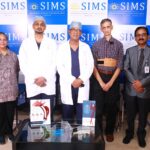Dr Himmatrao Bawaskar evaluated 888 patients; of these, 508 had diagonal earlobe crease. Of these 486 (95%) had ischemic heart disease, 264 (52%) had diabetes and 508 had high BP.
New Delhi, September 18, 2018 : In India, significant number of individuals suffers from ischemic heart disease (IHD). Majority of chest pain victim initially report to his family physician. At times, sudden death is the first and last manifestation of IHD. Doctors are aware of various risk factors for IHD. The diagonal ear lobe crease (DELC) has been characterized in medical literature as a surrogate marker which can be easily identified as high‑risk case for impending IHD.
Still in rural setting, family physicians exist. Majority of villagers irrespective of severity illness first visits to their family physician. Because of improvement in literacy, villagers are health conscious. Acute infectious diseases like diarrhea, bacillary dysentery, cholera, chicken pox, measles scabies, and worm infestations are on the way of vanishing. These diseases are replaced by noncommunicable diseases (NCDS) like hypertension, ischemic heart diseases (IHDs), diabetes, and mental illness. General physicians are now aware of NCDS. The prevalence of coronary heart disease has progressively increasing from 10.4% to 13.1% during last decade in developing country like India. Pre‑hospital sudden death preceded by chest pain has led to a search of risk factors responsible for coronary heart disease (IHD). More than 200 risk markers of IHD have been identified. Major factors are hypertension, diabetes mellitus (DM), hyperlipidemia, hyper‑homocysteinemia, tobacco consumption in the form of smoking or tobacco chewing, obesity, sedentary stressful life, male sex, and familial history of premature IHD or sudden death.

- Frank in 1973 first time observed that the diagonal ear crease (DELC) associated with premature IHD. Lichtenstein et al.
- in 1974 reported that 47% had diagonal ear crease associated with myocardial infarction. Prevalence of ear crease often reported in the sixth to ninth decades of life.
- Presence of bilateral ear lobe crease often accompanied by vascular dysfunction, Postmortem study confirmed the significant positive correlation between the presence of ear lobe crease and coronary heart diseases. Similarly, risk of cardiovascular death were 1.55–1.74 times greater than those without crease.
- Male pattern baldness, diagonal ear lobe crease, and xanthoma alone or combination accompanied with increased risk of IHD and acute myocardial infarction.
- DELC is independent or accompanied with ischemic stroke in addition to IHD.[8] DELC can be easily seen while examining ear, nose, throat to rule out malignancy, IHD and carotid artery disease.
- Patients with classical IHD accompanied with risk factors had DELC at a higher frequency.
- In a busy outpatient department, clinical detection of earlobe crease may facilitate early diagnosis in patients at high risk for IHD
- It is reported that ear lobe crease is a premonitory sign of impending IHD, accompanied with hypertension, DM, hyperelipidemia, smoking, raised body mass index (BMI), and occipital baldness at peripheral hospital.
The Diagonal earlobe crease is one of the most visible tellitales of a diseased heat, says Dr Himmatrao, who practices in Mahad (Maharashtra) . He studies 888 patients who came with diseases common among Indians such as diabetes and hypertension, and found that 95% of those who had an ear crease had ischemic heart . Of the 888 patients 508 had an ear crease , he said.
The doctor whose work in snake and scorpion bites have earned international name, believes the ear crease could serve as a surrogate marker for doctors in resource crunch settings . “In india the majority of chest pain victims first go to family physicians . At times sudden death is the first and last manifestation of IHD, he said.”
Patients and Methods
Patients with the complain of chest pain at outpatient department from January 2012 to December 2015 were studied in detail and investigated to rule out angina pectoris, acute myocardial infarction, hypertension, DM, raised lipid levels, smokers, tobacco chewers, and occipital baldness. All the patients examined for presence of diagonal ear lobe crease (DELC) and investigated for BMI, height, electrocardiography changes, and coronary angiography. DELC is characterized by a deep, obliquely diagonal earlobe creases run from lower pole of the external meatus, diagonally backward to the edge of the lobe at approximately 45°.


Hypertension
Blood pressure Measured by mercury sphygmomanometer >140/90 mm hg included in hypertension group.[12]
Ischemic heart diseases
Classic manifestation of IHD is angina which is characterized by heaviness in the chest, squeezing or a burning feeling, or suffocation or difficult in breathing. Chest pain or discomfort radiated to left shoulder, neck, jaw, epigastrium, or inner side of left arm or at times both arms. Chest pain intensity is built up over period of minutes (less than 2–10 minutes). Pain may start with exercise or psychological stress and strain or cold weather. Unstable angina is characterized by severe intolerable chest pain at rest. Acute myocardial infarction is characterized by sudden onset of retro‑sternal severe agonizing chest pain lasting for >30 minutes or longer, pain referred to both shoulder and arms, associated with shortness of breath, profuse sweating, weakness, nausea, and vomiting or shock.[13] Electrocardiograms (ECG).‑Angina‑resting ECG may be normal. During chest pain, ST‑T changes suggestive IHD or positive stress test further evaluated by coronary angiography.
Dr Himmat Said, “This is simple Non invasive intervention can be noted while examination of patient in busy out patient department, health worker and non medicos. This will help early suspection of IHD and prevent sudden death which may be first and last synonyms.This is easy way to detect IHD prone victim at rural setting do not require any modern gadgets. “







